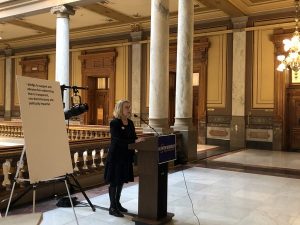Subscriber Benefit
As a subscriber you can listen to articles at work, in the car, or while you work out. Subscribe NowRedistricting reform advocates are taking a slightly different approach at the Republican-controlled Indiana Legislature this year, as they make more transparency the priority ahead of lines being redrawn in 2021.
For years, bills have been filed to create an independent redistricting commission that would be responsible for drawing district lines, but that legislation has not been successful. Political district boundaries are redrawn every 10 years using U.S. Census data, which means this session is the last opportunity to pass legislation before the 2020 population count.

The Indiana Coalition for Independent Redistricting will again advocate for the creation of an independent commission, but it is also pushing for simply making the process more transparent and has been working with a Republican state lawmaker on the issue.
State Sen. John Ruckelshaus, R-Indianapolis, said he filed a bill Monday morning that would create a new public website where the public can see population data and draw electoral maps that can be submitted for consideration. The bill also would require public hearings on the maps before approval.
“I am all in on redistricting reform this year,” Ruckelshaus said.
Julia Vaughn, policy director for Common Cause Indiana, said her watchdog group is “cautiously optimistic” that this legislation can earn enough support.
Vaughn said advocates will still push for the creation of an independent redistricting commission, but they know their odds are steeper for that measure.
“We’re skeptical that we’ll be able to pass that in the short session,” Vaughn said.
Ruckleshaus and Senate Minority Leader Tim Lanane said they are both filing bills that would establish a redistricting commission.
“Some of us have been working on this for 20 years,” Lanane said. “The question is—when is this finally going to happen?”
The coalition is also urging lawmakers to sign the nationwide End Gerrymandering Now pledge, which says they “support and advance fair redistricting that is transparent, non-discriminatory and politically impartial.”
More than a dozen lawmakers, both Republican and Democratic, had already signed the pledge as of Monday morning.
“I’m very proud to be a part of this,” Ruckelshaus said.
Please enable JavaScript to view this content.

Leave redistricting to the Legislature, but put a rule in place that once you start putting a district together, you cannot move out of the Township and County where you begin before the district has all the people it needs. Once you fill that township, you can move to an adjacent one, but not out of the County until it too is totally used up. I would also require that State Senate districts be comprised of exactly 2 Indiana House districts.
Each house district needs roughly 70,000 people. If you began in any township of Fulton County, you would stay in Fulton to get its 20,500 people. Then you move to a township in an adjacent County, say Pulaski. After getting its 14,000 residents, you move to Starke and pick up 24,000 more. The total is now 11,500 people short. You step over to Marshall and pick up a couple townships and you’re done.
History has shown that the Legislature can’t be trusted with this job so I support this effort. However, the chances that the Legislature relinquishes this responsibility are remote so your idea has merit. Start the process with the township in the center of the County’s largest City (or the most populous township). For Indy that would be Center, for Evansville use Pigeon, for Fort Wayne use Wayne. And then, as you describe, add other townships until the legislative District is complete.